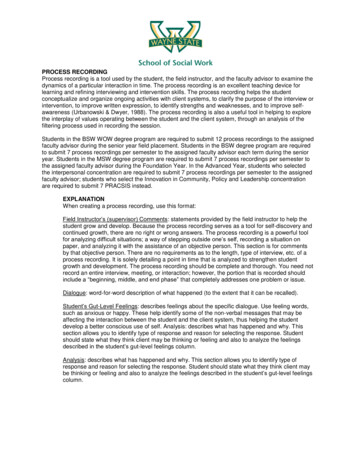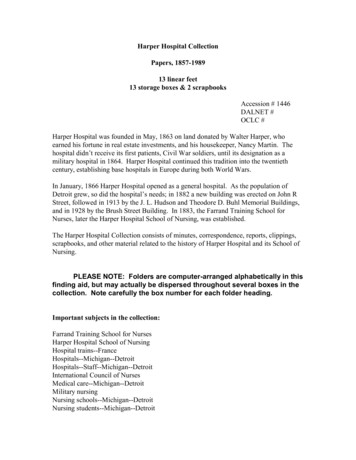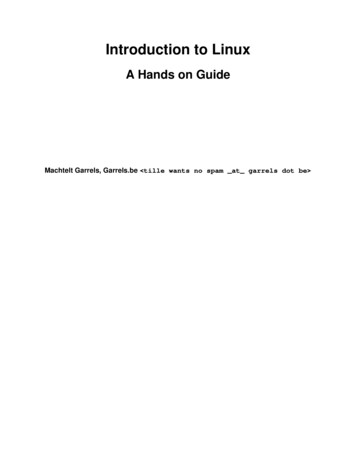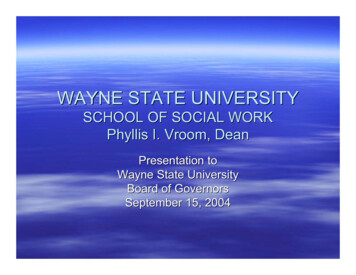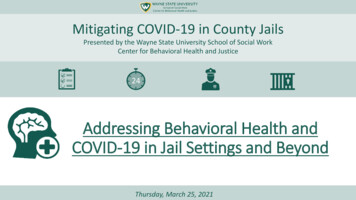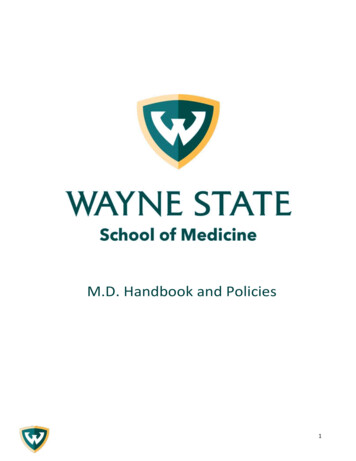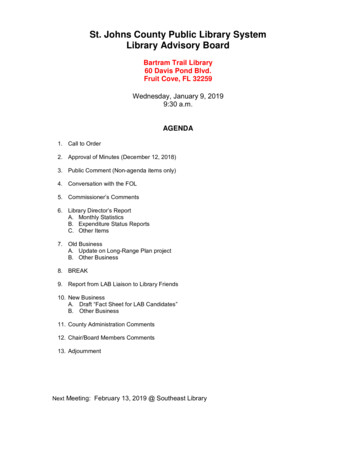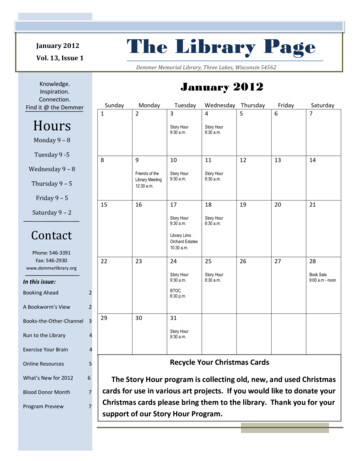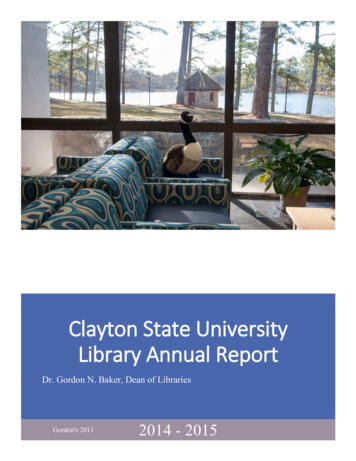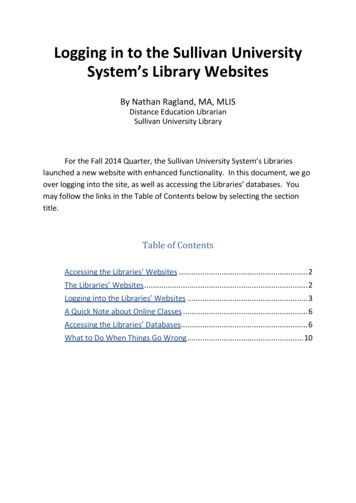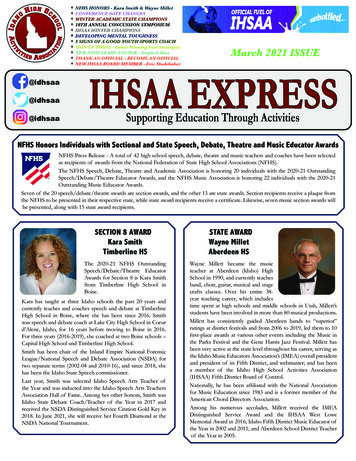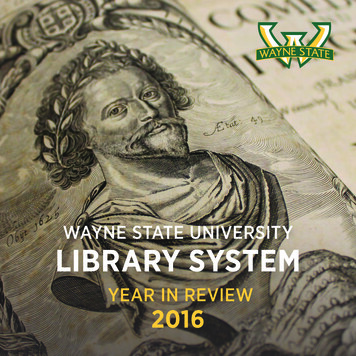
Transcription
WAYNE STATE UNIVERSITYLIBRARY SYSTEMYEAR IN REVIEW2016
WAYNE STATE’S MISSION:We will create and advance knowledge,prepare a diverse student body to thrive,and positively impact local and global communities.
subscriptions, only 12,984 were electronic. In 2016, we held 42,381 ejournals and no longer even keep track ofprint, as ejournals have grown so substantially that it is redundant to distinguish between print and electronic.In 2014, we held 23,727 ebooks — that number skyrocketed to nearly 1.1 million in 2016. I couldn’t be morepleased to see my vision become an electronic reality!It’s important to remember that moving forward can’t happen without expert librarians and staff to bringnew ideas and innovations to life. Early in my tenure at Wayne State, we had a single webmaster and one weblibrarian. Seeing the digital future, we began building a foundation that would help support the types of projectswe would be taking on. Today, that two-person team has grown into two fully staffed departments dedicated todigital projects and publishing, discovery and innovation. With the added staff and the creation of a digitizationstudio, we’ve added many full-text, open-access digital collections, including our own Ramsey collection and,most recently, the entire run of the Detroit Sunday Journal strike newspaper, which you’ll read more about in thisreport. We’re now turning some of our focus outward through our own DigitalCommons@Wayne by partneringwith university departments to publish journals and digitize historical books and documents. We are deeplyengaged in launching the Michigan Hub for the Digital Public Library of America. This entire infrastructure willleave the libraries in an excellent position for growth and opportunities within the university and beyond.A MESSAGE FROM DEAN SANDRA YEEGreat libraries and excellent library staff are the heart of every top research institution. Libraries — and theinformation profession in general — are in a state of constant change, which promotes even better access toinformation; safe, collaborative spaces; and technical capacity that allows access to electronic, visual, voice andprint materials faster and more efficiently than ever. At Wayne State University Libraries and the School of Libraryand Information Science, our goal is to embrace the best of what libraries and the information profession havebecome, and continue offering our clients access to excellent resources and programs; knowledgeable andfriendly staff; and clean, safe and useful spaces, both on campus and through our virtual services.Over the past 16 years, I have had the honor of serving the university as well as the libraries and SLIS. As manyof you may already know, I will be stepping down from my role as dean at the end of this summer. It was abittersweet decision, but I am confident that I am leaving the libraries and the School of Library and InformationScience in a position to continue the trajectory we have established. In my time here, we’ve seen the librarieschange at all levels. When I began at Wayne State, we were just starting our journey on the shift from printto electronic. The power of electronic access was apparent, and in order to take full advantage of that power,we changed our purchasing strategies to propel us into the electronic age. In 2004, out of 20,940 journalDuring my time here, we’ve been able to update our physical spaces. Based on the feedback of students lookingfor traditional, quiet study space, we completely reworked the first floor of the Purdy/Kresge Library, relocatingall the stacks and reference materials and making it exclusively a quiet study space. We’ve made tremendousstrides in opening up the library to create more study spaces and let in more light to encourage a warmer, saferand more comfortable environment. Gone are the dark upper floors, now replaced with technology, studyfurniture and — perhaps most importantly — sunlight throughout! In 2016, we worked on changing the secondfloor of the David Adamany Undergraduate Library to flexible, technology-rich collaborative space, which you’llhear more about in the 2017 annual report.2016 was an amazing year of growth and change for the libraries and SLIS. We added new staff, projects andcollaborations that you’ll read about in the report. The School of Library and Information Science successfullyachieved reaccreditation from the American Library Association Committee on Accreditation. This is the third fullaccreditation that the school has received since I joined Wayne State University, and we are very proud of its 50years of continuous accreditation.I’m so proud of everything that the libraries have accomplished over the years I have served as dean. I couldeasily fill an entire book with examples of excellent service, ideas, partnerships, innovations and stories of peoplewho have supported my vision over the years. The excellent staff members at the University Libraries and theSchool of Library and Information Science are the cornerstone of what we do and what we will continue to do.Since 2001, we have embraced and conquered the many challenges we have encountered including budgetreductions, leadership changes at the university, and the re-envisioning of Midtown and Detroit. I know that thenext leader will start here and will continue to move our organization forward.Thank you for all of your support throughout my time at Wayne State,Sandra Yee
O2 SUCCESS SESSIONSADVENTURE GAMEIn August, the libraries participated in theOrientation Two Success Sessions (O2) with acrowd of over 200 students, nearly double theparticipation from 2015. Held universitywide,O2 Success Sessions introduced students to theresources and services at Wayne State University,and helped students build personal connectionswith the university community.TIM GRITTEN JOINS LIBRARIESAS ASSOCIATE DEANIn February, Tim Gritten joined the libraries as the new associate dean. Gritten came to Wayne State from theUniversity of Wisconsin-Milwaukee Libraries, where he was the assistant director of libraries for user services.Gritten has more than 20 years of experience, serving in escalating roles within circulation, collections,acquisitions, technology and administration.In his role at the Wayne State Libraries, Gritten focuses on developing and implementing library programs andservices to align with the university’s strategic goals, leading academic staff, and expanding and enhancingclassroom technology.Gritten earned his master’s in library science from Indiana University and bachelor’s degrees in anthropology,classics and history from the University of Illinois at Urbana-Champaign. He served on several Association ofCollege and Research Libraries editorial boards and committees, and as a mentor and committee member in theLibrary Leadership and Management Association. Gritten’s research interests include open access, copyright, fairuse and publishing.For 2016, library staff and graduate studentassistants took students on “A Day in the Lifeof the Library” adventure with a game thattook small groups of students through eightstops in Undergraduate Library. At each stop,the group played games and solved puzzles tohelp their assigned student character completea successful day at the library. Students learnedto use printers and copiers, locate the OneCardmachine, reserve a study rooms, find libraryresources, locate our service and help desks,and more.I think this was a greatsession! I learned a lot and itwas never boring. I’m so gladI did this session because Ifeel more confident on wherethings are located in the library!I definitely plan on making fulluse of the services.”
DETROIT SUNDAYJOURNAL DIGITALCOLLECTION ADDEDIn the spring, the libraries launched a digitalcollection containing all issues of the DetroitSunday Journal, the publication produced bynewspaper union workers who went on strikefrom the Detroit News and Detroit Free Pressin July 1995. Spanning four years and justover 200 editions, the Sunday Journal was aweekly tabloid newspaper that was availablethrough the mail, in stores and at corner boxesthroughout Southeast Michigan.The libraries digitized every issue of the SundayJournal, from Nov. 19, 1995, to Nov. 21, 1999.Though the newspaper strike formally endedin 1997, the paper continued to run as workerswere slowly rehired and ongoing disputes weresettled. “The Sunday Journal is a key piece ofDetroit’s historical record, a counterpoint tothe narrative of relentless media consolidation,”said Joshua Neds-Fox, coordinator for digitalpublishing at Wayne State. “We’re really proudto see this newspaper digitized, available in fulltext, fully searchable and to know that the workof a lot of dedicated librarians, archivists andstudents is culminating in this vital collection.”The Sunday Journal was one of the longestlived strike newspapers ever and will likely bethe last major one, given the diminished stateof the print industry and the rise of accessibleand inexpensive online journalism. Two formerSunday Journal reporters have gone on to winPulitzer Prizes, journalism’s most prestigiousaward.HOW DOES YOURGARDEN GROW:URBAN GARDENINGIN THE CITYIn April, Shiffman Medical Library Outreachheld “How Does Your Garden Grow: UrbanGardening in the City,” a panel discussion thatdiscussed maintaining a healthy garden, itstherapeutic benefits, food systems and theirimpact on the environment and health, andother urban gardening projects throughoutthe city. Panelists included Ashley Atkinsonfrom Keep Detroit Growing, Winona Bynum ofthe Detroit Food Policy Council and TepfirahRushdan from The Greening of Detroit.Held at One Ford Place in New Center, thediscussion was open to the public and includedsample snacks from local gardens and aninformative question and answer period at theend of the program.MICHIGANNOTABLE BOOKSIn April, as part of her Michigan Notable Bookstour, editor Sara Kosiba discussed What Happens,originally written by John Herrmann, Lansing’smost forgotten author.Born in 1900, Herrmann came from a successfulLansing family that owned John Herrmann’sSons, the largest bespoke tailor in the state.Deemed obscene, his 1926 novel What Happenswas confiscated and banned in the UnitedStates, only being published in Paris. Theobscenity trial he eventually lost was one of thefirst major tests of community standards andobscenity. Once husband to the writer JosephineHerbst, Herrmann is noted for his radicalwritings and close association with the U. S.Communist Party. He served in the U.S. CoastGuard during World War II and later moved toMexico, where he connected with beat writersincluding William Burroughs. He died in 1959.Every year, the Library of Michigan selects up to20 of the most notable books, either written bya Michigan resident or about Michigan or theGreat Lakes. The selected books are honoredin the year after their publication or copyrightdate. Each selected title speaks to our state’srich cultural, historical, and literary heritage andproves without a doubt that some of the greateststories are found in the Great Lakes State.
1,001DEPOSITS IN2016, INCLUDINGWSU PRESSARTICLES405WSUDISSERTATIONSAND THESESPUBLISHED2016 DOWNLOADSDIGITAL COMMONSHITS A MILLIONDOWNLOADSIn 2016, thanks to the contributions ofWayne State faculty and researchers, WayneState’s DigitalCommons@WSU hit 1 milliondownloads. Started in 2005, DigitalCommons@WSU began seeing huge growth in 2011 withthe addition of an institutional repositorylibrarian, who worked with faculty to gettheir materials into DigitalCommons@WSUand make their work open access. The use ofDigitalCommons@WSU brings more visibilityto our faculty and significantly increasesresearch impact. “By making Wayne Statearticles open access, researchers across theglobe were able to download 1 million itemsthat may have otherwise been inaccessible tothem, further extending the reach and impactof this scholarship,“ said Mike Priehs, scholarlycommunications coordinator.336,381ALL-TIME DOWNLOADS1,247,313212NUMBER OFCOUNTRIESDOWNLOADINGCONTENTLIBRARIAN MINHAOJIANG SELECTED ASALA EMERGING LEADERIn October, Software Development LibrarianMinhao Jiang was one of 50 people selectednationwide to serve as an American LibraryAssociation Emerging Leader. The EmergingLeaders program is designed to allow librarystaff and information workers to participate inproject-planning work groups, network withpeers, gain an inside look into ALA structure andhave an opportunity to serve the profession ina leadership capacity early in their careers. TheEmerging Leader participants commit to takingpart in all aspects of the program and may havean opportunity to serve on an ALA division,chapter, round table or affiliate committee uponcompletion.Jiang was sponsored by the Chinese AmericanLibrarians Association, which will help defraythe costs associated with attending the ALAMidwinter Meeting and Annual Conference.
AMERICAN BARASSOCIATIONSITE VISITAs part of the Wayne State University LawSchool accreditation process, the Law Schooland Law Library were visited by a team ofdistinguished academics and practitionersrepresenting the American Bar Association (ABA)and the Association of American Law Schools inApril.Although the Law Library is not part of theadministrative structure of the Law School,it plays an essential role in supporting legaleducation. The ABA standards encompass LawLibrary administration, collections, services andfinancing. For the Law School to be reaccredited,the Law Library must also demonstrate that itcomplies with these standards.The ABA site evaluation team reviews thematerials the school has provided and visits theschool for a three-day period. During that visit,the team meets with the dean and other leadersof the faculty and law school administrationas well as the president and other universityadministrators. The team also visits as manyclasses as it can during its visit to makejudgments concerning the quality of instruction,holds an open meeting with students and meetswith student leaders. At the end of the visit, theteam meets with the dean and the presidentor, in the case of independent law schools, theboard chair to provide an oral report of theteam’s findings. Early evaluative feedback atWayne State was positive.WHO MAKES THELIBRARY? CAMPAIGNA library is only as good as its staff – which iswhy the Wayne State University Libraries areamazing! Not only does our staff care aboutcustomer service and helping our studentsand faculty find the resources they need, butthe libraries are filled with knowledgeablepeople. To kick off the fall semester, thelibraries launched “Who Makes the Library?”This new campaign features Wayne StateLibraries staff members who are applying theirlibrary knowledge beyond the walls of thelibraries as well as their personal knowledgeto their work at Wayne State. From specializedvideo production skills and web design to artsand music, our library staff is rich with talentthat benefits the libraries and our users. Wethink you’ll be surprised to see the interestingand incredible things that people are doing!Visit library.wayne.edu to see a new featureeach month.
CHAT REFERENCE STATS2,378CHATS108TEXTSTOTAL CHATS AND TEXTS2,48612:15AVERAGETEXT LENGTH11:14AVERAGECHAT LENGTHThanks forbeingavailableon aSunday!
Wayne State University, in collaboration with the Detroit Institute of Arts and the DetroitPublic Library, was selected as the host site for the state of Michigan for First Folio!The Book that Gave Us Shakespeare, a national traveling exhibition of the ShakespeareFirst Folio, one of the world’s most treasured books. The Folger Shakespeare Library,in partnership with Cincinnati Museum Center and the American Library Associationtoured a First Folio of Shakespeare to all 50 states, Washington, D.C., and Puerto Ricothroughout 2016.
For its Michigan visit, programming included agala opening night, an international conferenceof Shakespeare scholars, film screenings,theatrical performances, teacher educationworkshops, Shakespeare trivia competitions, aswell as a special Knowledge on Tap and WayneState Insiders program dedicated to Shakespeareand the folio. The Folio was on display in theDetroit Institute of Arts while the accompanyingpanel exhibit was hosted at the David AdamanyUndergraduate Library at Wayne State.Additional programming was held at the DetroitPublic Library, including an exhibition of theirsecond and fourth editions of the Folio.Many of Shakespeare’s plays, which werewritten to be performed, were not publishedduring his lifetime. The First Folio is the firstcollected edition of Shakespeare’s plays. Itwas published in 1623, seven years afterShakespeare’s death. Two of Shakespeare’sfellow actors compiled 36 of his plays, hoping topreserve them for future generations. Withoutit, we would not have 18 of Shakespeare’s plays,including Macbeth, Julius Caesar, Twelfth Night,The Tempest, Antony and Cleopatra, The Comedyof Errors and As You Like It. All 18 appear for thefirst time in print in the First Folio, and wouldotherwise have been lost.
12%DROP-INLIBRARIAN LTOTAL QUESTIONSLAW 226SOCIAL WORK86EDUCATION 65ENGINEERING61CLAS HUMANITIES52CLAS SCIENCE51CFPCA 26CLAS SOCIAL SCIENCES 21OTHER 16HONORS 15LIBRARY SCIENCE5BUSINESS 2MED 2NURSING 1NOT REPORTED162948MINUTESPERQUESTION1-9 MIN14343810-19 MIN20 MIN
LIBRARIES ROCK NOEL NIGHTTo further increase our engagement with the community, the librariesparticipated in Noel Night, an annual winter celebration in Midtown whereinstitutions and businesses open their doors to the public in a Cultural Centerwide open house. The libraries took over the Prentis fish bowl on December 3for a musical showcase that included talent from staff and friends of the Librariesperforming 50s throwback, Irish, folk and punk music. Thanks to the prominentlocation on Cass, there was a great crowd throughout the entire evening.The Reuther Library also opened its doors to the public with behind-the-scenestours and an introduction to some of their materials., including an activity wherevisitors could pose in cutouts of historic images and take a photo card home ofthemselves. Watch for us again at next year’s Noel Night!REUTHER LIBRARY UNVEILS WALTER SPECK MURALIn October, the Reuther Library held a reception to celebrate the unveiling of Walter Speck’s WPA-era muralknown as “Ford Riot.” The mural showcases several pivotal moments in the UAW’s formation, including the1936-37 Flint Sit-Down Strike, the 1937 Battle of the Overpass at Ford Motor Co., as well as a painted renderingof Local 174’s first contract. Local 174, Walter Reuther’s home local, commissioned this artwork and others toenliven their union hall and teach members about their history in the fight for working people.After hanging in various Local 174 union halls for nearly 75 years, the mural was water- and tobacco smokedamaged, dulled, and had significant tears. When the Detroit local moved its union hall in 2014, there was littleroom for the 9-foot by 20-foot artwork. Thanks to a collaboration between the local and the Reuther Library, thisvaluable piece of labor history was painstakingly restored and moved to the library so that union members andthe general public can look back on key moments in Michigan’s rich labor history.The project was nominated for the Reference and User Services Association’s John Sessions Memorial Award, whichrecognizes a library which has made a significant effort to work with the labor community and by doing so broughtrecognition to the history and contribution of the labor movement to the development of the United States.
SPECIAL COLLECTIONSTEAM CELEBRATESCIVICS DAY WITH THEHENRY FORD ANDHISTORY DEPARTMENT2016 WEBSITE ENHANCEMENTSThanks to ongoing usability studies, the libraries’ website underwent several changesthroughout 2016, using user feedback to guide the modifications. In the beginnin
At Wayne State University Libraries and the School of Library and Information Science, our goal is to embrace the best of what libraries and the information profession have . 2016 was an amazing year of growth and change for the libraries and SLIS. We added new staff, projects and collaborations that you’ll read about in the report. The .
